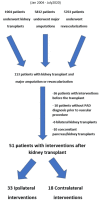Rate of Ipsilateral Chronic Limb-Threatening Ischemia (CLTI) After Kidney Transplantation: A Retrospective Single-Center Study
- PMID: 35774684
- PMCID: PMC9239297
- DOI: 10.7759/cureus.25455
Rate of Ipsilateral Chronic Limb-Threatening Ischemia (CLTI) After Kidney Transplantation: A Retrospective Single-Center Study
Abstract
Objective: To analyze whether the rate of lower extremity (LE) ischemia is higher on the ipsilateral side after kidney transplantation.
Methods: Our institutional transplant database was retrospectively queried for all patients who received a kidney transplant and underwent subsequent LE revascularization or major limb amputations between January 2004 and July 2020. The one-sample binomial test was used to test whether the LE ipsilateral to the transplanted kidney was at higher risk of peripheral arterial disease (PAD) complications necessitating intervention (major amputation or revascularization).
Results: There were 1,964 patients who received a kidney transplant during the study period. Of these, 51 patients (3%) had subsequent LE arterial revascularizations or major amputations. The mean age was 58 ± 10 years, and 37 patients (73%) were male. A total of 33 patients had ipsilateral LE vascular interventions (26 major amputations and seven revascularizations) while 18 patients had contralateral vascular interventions (14 major amputations and four revascularizations) (P = 0.049). The average interval between transplantation and subsequent vascular intervention was 52 months for the ipsilateral intervention group and 41 months for the contralateral intervention group (P = 0.33).
Conclusions: In patients who received kidney transplantation and required subsequent LE surgical intervention, we observed an association between the side of transplantation and the risk of future ipsilateral LE arterial insufficiency. Further studies are needed to determine the etiology of this association.
Keywords: chronic limb threatening ischemia; end-stage renal disease; kidney transplantation; lower extremity revascularization; peripheral artery disease.
Copyright © 2022, Natour et al.
Conflict of interest statement
The authors have declared that no competing interests exist.
Figures
References
-
- Infrapopliteal angioplasty for limb salvage in the setting of renal failure: do results justify its use? Aulivola B, Gargiulo M, Bessoni M, Rumolo A, Stella A. Ann Vasc Surg. 2005;19:762–768. - PubMed
-
- Results of lower extremity amputations in patients with end-stage renal disease. Dossa CD, Shepard AD, Amos AM, et al. J Vasc Surg. 1994;20:14–19. - PubMed
-
- Endovascular management of critical limb ischemia in renal transplant patients. Gilmore D, Dib M, Evenson A, Schermerhorn M, Wyers M, Chaikof E, Hamdan A. Ann Vasc Surg. 2014;28:159–163. - PubMed
-
- A decade experience with infrainguinal revascularization in a dialysis-dependent patient population. Ramdev P, Rayan SS, Sheahan M, et al. J Vasc Surg. 2002;36:969–974. - PubMed
-
- Potential predictors of outcome in patients with tissue loss who undergo infrainguinal vein bypass grafting. Seeger JM, Pretus HA, Carlton LC, Flynn TC, Ozaki CK, Huber TS. J Vasc Surg. 1999;30:427–435. - PubMed
LinkOut - more resources
Full Text Sources


